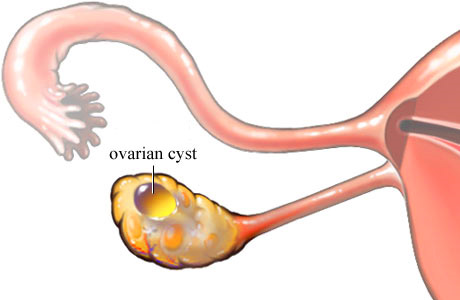
Believe it or not, every menstruating woman produces a cyst every normal menstrual cycle. But sometimes these cysts keep growing- that’s when they become a problem.
The most common ovarian cysts are called functional cysts because they result from the function of the ovaries. Every month an ovary releases an egg, which has matured inside a follicle, a fluid-filled sac with a thin membrane, in effect a small cyst. sometimes the follicule continues to grow beyond its normal pea-size and if it reaches three-quarters of an it is called a follicular cyst. Often there are no symptoms and with luck the cyst will simply shrink within two to three menstrual cycles.
The second type of functional cyst is a corpus luteum cyst, named after the hormone-releasing tissue left when a follicule has released an egg. The hole through which the egg has been released closes over and the membrane fills with fluid or even blood. The cyst continues to grow but rarely secretes hormones. A corpus luteum cyst can cause pain in the lower abdomen, but it too is most likely to dissolve within a few cycles.
Either type of cyst can burst once they reach more than three or four inches. The sudden pain of a rupturing cysts is frightening enough to warrant a trip to the A&E. Functional cysts are never cancerous.
Chocolate cysts

“Chocolate” cyst
For endo women the name of chocolate cyst is all-too-familiar as 60% will have endo on their ovary. The proper term is endometrioma or endometriotic cyst, which forms on the ovary from tissue similar to the lining of womb. These implants grow and bleed in the same way the womb’s lining does during the menstrual cycle. The cysts are filed with dark brown chocolate-coloured blood and if they burst the pelvic area and surrounding organs can be affected by the spreading of endometrial implants causing severe scarring and adhesions and pain.
Endometriomas can cause significant damage to the ovaries, affecting hormone production and fertility. The damage may be so great that part of the ovary has to be removed (cystectomy) and in some cases the whole ovary and the fallopian tube can be lost. Immediate action is needed upon the diagnosis of endometrioma, either hormone treatment to suppress a woman’s periods and shrink the cysts and other endometriotic implants, or surgery to remove them.
Neoplasms
Cyst adenomas are growths or neoplasms, which grow from ovarian tissue either inside or on the surface of the ovary. They occur most frequently in women aged 30 to 50. There are two types: serus cyst adenoma filled with watery fluid and mucinous cyst adenoma filled with a thick. sticky material. Serus cyst adenoma can reach 6 inches in diameter, while the mucinous type are often bigger, 6 to 12 inches, in some cases becoming giants of 40 inches. They press on the intestines, stomach and bowels and interfere with normal functioning and also damage the ovary. They are mostly non-cancerous, called benign tumours, but they have the potential to become malignant (cystadenocarcinoma).
Dermoid cysts or teratomas contain teeth, hair or skin tissue because they form from cells that produce human eggs. They may be present from birth. They can cause problems in later years, enlarging and twisting to cause sever pain, or they can be symptomless and remain undetected until a routine medical procedure shows them up. They can grow to a huge size before they cause symptoms and there is a 15% chance of the same cyst growing on the contralateral ovary.

Dermoid Cyst
How do I know I have a cysts
Often, a woman will notice a cyst is during a routine pelvic examination at her doctors’ office. sometimes the doctor can feel the cyst during a bimanual examination. A vaginal ultrasound scan will also show up a cyst and enable the doctor to determine its type. if the ultrasound is unclear a CT scan may show more. Functional cysts have one compartment, usually filled with clear fluid or blood, and are smooth in shape. Cyst adenoma and dermoid cysts show up with solid matter inside, more than one compartment or irregular shape. Chocolate cysts are difficult to diagnose with a scan alone.
Cysts may create symptoms, which you should take seriously and discuss with your gynaecologist. The symptoms listed below can indicate an ovarian cyst if there is no ready explanation, such as indigestion.
- Feeling of heaviness or pressure in the pelvic area
- Swelling or fullness of the abdomen
- Pain during intercourse
- Dull ache on one or both sides of the pelvic area
- Late, missed or irregular periods
- Weight gain
- Constipation or difficulty emptying bladder
Consult your doctor without delay if you have the following:
- Sudden, acute onset of pain in the pelvic area
- fever accompanied with,
- Nausea and vomiting
The above symptoms can also be present for endometriosis, pelvic inflammatory disease (PID), ectopic pregnancy (pregnancy outside the womb) or appendicitis.
Treatment of cysts
Once the doctor has diagnosed an ovarian cyst she/ he will look at a number of factors before deciding on a treatment. These include:
- Type of cyst
- Age
- Medical history and Family history
The preferred treatment for a functional cyst is continuous monitoring. In the next appointment, in one to four weeks, the doctor will monitor its growth. Often nature takes care of the problem and the cyst dissolves, but if it continues to grow the doctor may prescribe the contraceptive pill to suppress ovulation, which should cause a functional cyst to shrink.
If one is already on the pill or has reached menopause then she is not ovulating so the cyst is unlikely to be a functional cyst. If the cyst continues to grow beyond two inches or scans do not show clearly what kind of cyst the woman has, the doctor will play it safe and proceed with a laparoscopy to determine the exact nature of the cyst and allow for its removal in a cystectomy. The idea of surgery can be distressing, however it is reassuring to have a definite answer to immediate worries. For most people one worry will be cancer, but the vast majority or ovarian cysts are not cancerous.
If one has a history of endometriosis or other gynaecological problems, including infertility and irregular periods, the doctor may also opt for an early laparoscopy. Any cyst discover in a woman over the age of 50 or in a girl before puberty will always be taken most seriously.
Self-care
There is no known way to avoid ovarian cysts, which makes it important for all women to have regular check ups with their gynaecologist. Symptoms with no obvious explanation should be investigated as soon as possible so that your doctor can assess the situation and take early action. Remember that your health is important and your body is precious.
Leave a reply








